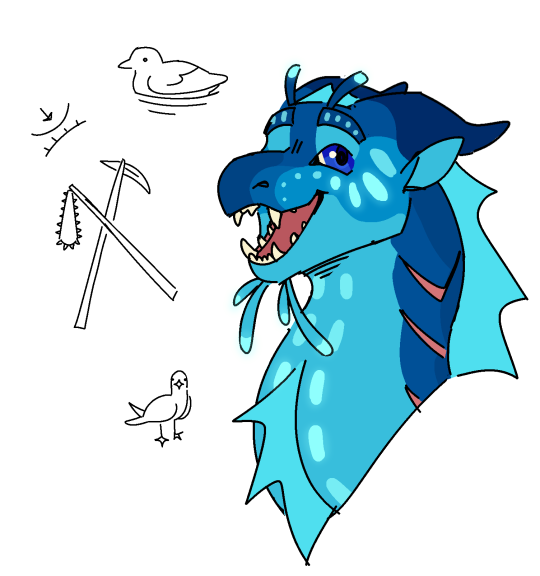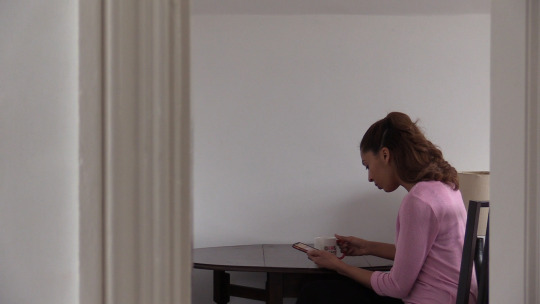#also redux content! I want to post more but im not very confident in my dragon art so we'll see
Text

tsunami is autistic here she is talking about her special interests <3
[ ID: A digitally drawn headshot of Tsunami from Wings of Fire. It looks like she’s happily talking about something. In her speech bubbles are several simple black and white drawings: a Cassin's auklet swimming and causing ripples, two weapons crossed, a seagull standing with its head turned towards the viewer. End ID]
#source: I am autistic and I care her#her special interests r battle tactics/history and seabirds btw :] the seabirds develop post arc 1 but it starts off when she sees#auklets feeding their chicks in the sea kingdom during tlh... thats why she names her little sister auklet#also redux content! I want to post more but im not very confident in my dragon art so we'll see#tag for it tho:#keeb wof#also#keeb art#wof#wings of fire#tsunami#wof tsunami#keeb roars#img Id by firnmist#thank u!
238 notes
·
View notes
Text
Production Journal - Being John Malkovich
210220
Being John Malkovich (1999) is a haunting film that asks viewers to surrender to a fantastically absurd premise. It was Spike Jonze’s directorial debut and he received an Academy Award nomination for such a bold undertaking. The plot follows Craig Schwarz, a struggling street puppeteer, his affectionate wife Lotte and his office infatuation Maxine. Relations between them cycle between attraction and repulsion when they discover a portal into the brain of John Malkovich. Its intrepid moments of comedy were met with praise and fascination from critics. ‘Put simply, Being John Malkovich just has to be one of funniest, cleverest films of the year, a Fabergé egg of comic delight,’ were Peter Bradshaw’s closing remarks in his review. (Bradshaw, 2000)
Director of Photography Lance Acord (Born 1964) is Jonze’s long term collaborator. Between them they have the hipster credentials to deliver trendy music videos, independent films and Hollywood blockbusters. With Being John Malkovich (1999) they developed a visual language which was darker derived from traditional set ups and framing. ‘We shot most of the scenes very simply. We didn’t have that much time to do them, and instead of breaking down each scene into ten setups, I wanted to spend my time getting performances from the actors,’ Jonze explained in interview. He continued, ‘That was a conscious decision, but I thought it worked for the movie - not to make it big, flashy and overly into technique. Lance can confidently and quickly work with little equipment. And, also, he doesn’t care so much what his peers are going to think.’ Given that the film explores such abstract concepts, it is largely due to Accord’s efforts that the viewer is able to suspend disbelief and lose themselves in the cinematography. (Macaulay, 2019)
Being John Malkovich (1999) has philosophical appeal for its portrayal of same-soul theory - a model of Cartesian dualism that suggests individuals identify with a consciousness unique to them. In essence, a person may be themselves within the vessel of someone else. The functionality of the portal may be likened to a cerebroscope - a fictitious device capable of relaying the contents of someone’s brain to another individual. The film addresses this phenomenon by switching to an occluded camera view analogous to peering through a periscope. The feeling of voyeurism is elevated by drawing attention to Malkovich’s bodily processes akin to the auditory effect of an isolation chamber. In a comically pedestrian scene, he orders a bath mat and scours his kitchen for Chinese food; however, the cinematography makes the act seem supernatural. Several levels of this interaction are explored when Maxine has a date with Lotte as Malkovich and Malkovich enters the portal to witness his own conscious mind in a perverse paradox loop. The filmmakers breech the fourth wall and meander either side of it to the point that it is accepted these characters are familiar with the real actor John Malkovich and his friend Charlie Sheen. (Koch, 2011) (Shaw, 2006) (Weinstein, 2008)

Summary
Jonze’s classic film takes time to develop layers of reality that act as a platform for facets of philosophy and science. In comparison, my film will be minutes long and undertaking anything of the same magnitude would be ambitious. I would like there to be a change in the rhythm of the footage that I will create with my own production technique. During an email conversation with lecturer Teemu Hupli, we discussed this issue and the potential avenues that I may partake.
‘Something has been ringing in my head since we spoke last Friday, and I want to voice it. You said a sentence in our chat to the effect that ‘the toil’ behind finished pieces of dramatic art (by which I understand films, plays, TV performances of various kinds) is ‘often not seen’ and your proposed project would expose that side of things. I am not saying it is often seen, but I would suggest you research the basis of this assertion. We do have films / representations of the work that goes into making pieces of dramatic art - cinema by now has a lot of them e.g. Synecdoche, New York, Being John Malkovich, Mulholland Drive, Inland Empire, and theatre has messed around with the fourth wall at least since the modernist times. In general, the idea of exposing the structures ‘behind’ finished products of art falls under the broader rubric of self-reflexivity, which has become a relatively widely used strategy for slightly more experimental dramatic art. I did mention structuralist film in our chat, which was based exactly on that idea, although it was not always about exposing the toil of actors alone, but often focused on the materials and editing structures of film e.g. Michael Snow’s Wavelength, which is essentially one very long inward zoom with marginal - literally in the margins of the frame - events occurring in the room.
I believe it would be important for you to acknowledge that your project might be operating in the context of such experiments in film / theatre. This is not to say that you should not follow your idea, but that you need to ensure that you are as fully cognisant as possible about the art / film historical context in which you work, in order to develop a clear sense of where you might be doing things similarly and / or differently from the context.’
Production Notes
An original musical score by György Englert provides some clue that Natalie might be an actor playing an actor. Lady Gaga’s Shallow (2018) and Joseph Arthur’s In the Sun (2003) were the inspiratory prompts that I gave him. I like the way both songs become more upbeat as they progress; however, melancholic accents are apparent throughout. Englert’s gypsy jazz roots contribute a playful quality that is also implicit of these shifting intentions.
After the title fades the film begins with a conventional shot seen in television interviews - framing tight to the subject and emphasising facial gestures. There is a second shot positioned further away to add some variation and then photographs from Natalie’s career roll across the screen. Momentum is broken for the first time when she slips and I encourage her to recuperate her thoughts. In the last scene of the interview there is an inaudible background comment from me, although this might be too elusive for the viewer to notice. These remarks were left in the final edit to break the fourth wall - the actor and the director are aware that they are part of a fictional narrative. In the scenes that follow, I added extracts from the scratch audio that are revealing of the filmmaking process. A focusing error while Natalie drinks tea was also left in. An early commercial cut of the film had these parts removed. It had a more mainstream tone and the intentions of the piece were lost. My peers encouraged me to be bolder with my post-production choices and this was the right direction for the project.
Being John Malkovich’s (1999) cerebroscope is recreated in the line reading sequence. The audience has a first-person view of Natalie’s performance as if they are me. There is a familiar fluidity to the play that she exudes. She waits in anticipation of her opening gambit and then launches into the role. Glances down to the paper script and then back to camera were the exact nuances that I wanted to capture. Scratch audio of me monotonously rattling off lines is heard at the start and then there is a fade away to a voice over. I selected the passages about her acknowledging nerves prior to a performance and method acting to superimpose over the visuals. Both give insight into the feelings that she may be experiencing in real time. Various edits exist where the scratch audio was omitted or faded out at a later frame. Feedback from these versions led me to believe that my speech was needed to frame the situation. Finally, I am pleased with the way that Natalie’s staring eye dominates the closing shot before the next scene.
Bibliography
Bradshaw, P. (2000). Bonkers but Brilliant. The Guardian. Available from
www.theguardian.com/film/2000/mar/17/1
[Accessed 10/04/2020]
Koch, C. (2020). Consciousness Redux - Being John Malkovich. Scientific American, 22 (1), 18-19
Macaulay, S. (2019). I’m In You - Director Spike Jonze and Screenwriter Charlie Kaufman Talk Being John Malkovich. Filmmaker. Available from
www.filmmakermagazine.com/107755-im-in-you-director-spike-jonze-and-screenwriter-charlie-kaufman-talk-being-john-malkovich
[Accessed 10/04/2020]
Shaw, D. (2006). On Being Philosophical and Being John Malkovich. Journal of Aesthetics and Art Criticism, 64 (1), 111-118
Weinstein, L. (2008). The Perverse Cosmos of Being John Malkovich - Forms and Transformations of Narcissism in a Celebrity Culture. Projections, 2 (1), 27-44




Final Cut, Manual Mode, 25 fps, WB Natural Light
0 notes